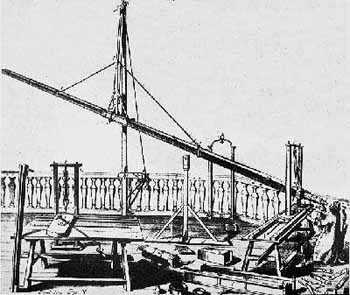Seeing the Universe
1673 - Hevelius' long telescopes
When astronomers tried to make high magnification telescopes they were thwarted by the dispersion of light that occurs in simple lenses. High curvature lenses form images marred by coloured fringes - the chromatic abberation effect. Telescope makers found they could minimise the effect and obtain high magnifications by making instruments longer. Around 1673, in a quest to obtain better views of the universe Hevelius made a series of instruments up to 42 metres long. One of the smaller scopes, 6 metres long, is shown here. The longer scopes were almost impossible to use due to the difficulty of keeping their lenses in line. It was difficult to align them accurately on targets as well, for their mountings were crude - the tube was simply suspended from a pole by ropes. Hevelius did his main work, compiling a catalogue of the positions of 1,500 stars, without telescopes.
The invention of the achromatic lens eventually solved the colour fringe
problem and enabled refracting telescopes of more manageble lengths to be
built. Over time, a range of precisely engineered mounting arrangements
were also developed.
![]() Early Telescopes
Early Telescopes

Image of Hevelius at his 6 m telescope from his book:
Machina Coelestis, 1673 (Rice University Galileo Project)